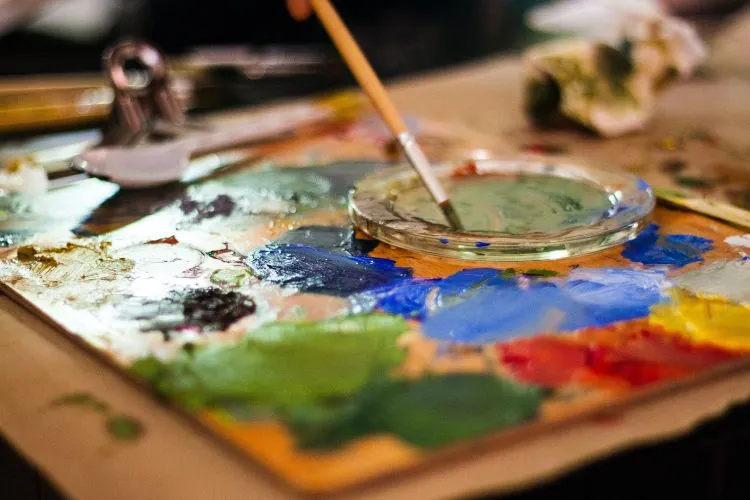The vibrant, quick-drying nature of acrylic paint has won the hearts of countless artists, crafters, and DIY enthusiasts. Its popularity is rooted in its incredible versatility, ease of use, and the vivid, long-lasting colors it can produce.
The vibrant, quick-drying acrylic paint has won the hearts of many artists and DIY enthusiasts. Its popularity stems from its versatility and the vivid colors it offers.
However, a lingering question among art creators and collectors is “does acrylic paint fade In sunlight?” Let’s learn.

Understanding Acrylic Paint Composition
Acrylic paint is a water-based medium, distinguished by its composition of pigment suspended in acrylic polymer emulsion. The quality of acrylic paint and its resistance to fading depend significantly on the pigment’s lightfastness.
Lightfastness refers to a pigment’s resistance to fading when exposed to light. Understanding this concept is crucial for artists who wish their works to endure the test of time.
Does Acrylic Paint Fade In Sunlight?
Sunlight can be both a friend and foe to artworks. While natural light can enhance the display of paintings, its UV rays pose a risk to the longevity of acrylic pieces. The UV rays break down the chemical bonds in the paint, leading to fading and color shifts.
This degradation process is not immediate but can result in noticeable changes over years depending on the exposure level and the lightfastness of the pigments used.
Pro Tips: Preventing Sunlight Damage to Acrylic Paintings
Artists can take several steps to protect their acrylic creations from sunlight damage. Applying a UV protective varnish over the finished painting forms a protective barrier that shields the pigments from harmful rays.
When framing artworks, selecting UV-protected glass or acrylic sheets can also offer an additional layer of defense against the sun. These measures are especially recommended for pieces displayed in areas receiving direct sunlight.

The Reality of Acrylic Paint Fading: What Experts Say
Research and expert opinions underline the importance of preventive measures to safeguard acrylic paintings.
Many believe that while no pigment is entirely immune to sunlight’s effects, those deemed to be lightfast can significantly withstand the damaging impact.
This resilience ensures the artwork’s vibrancy remains for decades, contingent on the quality of the materials used and the artist’s preventive actions against UV exposure.
Comparative Analysis: Acrylic vs. Other Paints in Sunlight
When pitted against other types of paints like oil or watercolor, acrylics hold their own in terms of durability under sunlight. Oils, known for their robustness, share a similar resistance to sunlight as high-quality acrylics.
However, watercolors and less lightfast acrylics tend to be more susceptible to fading. The primary distinction lies in the binding agents and the thickness of application, which contribute to the overall resilience of the painted work.
You may also read: How to Make Acrylic Paint Dry Faster?
Impact of Varnishing on Acrylic Paint’s Lifespan
Varnishing plays a pivotal role in enhancing the lifespan and preserving the appearance of acrylic paintings, especially when subjected to sunlight. The choice between matt and gloss varnishes is not merely aesthetic but can significantly impact a painting’s longevity and its resistance to the damaging effects of UV rays.
Gloss varnishes, with their shiny finish, tend to reflect light, reducing the direct exposure of the underlying paint layers to sunlight. This reflection creates a barrier that can help protect vibrant hues from fading and color shifting.
Additionally, the reflective quality of gloss varnish can enhance color saturation, making the painting’s colors appear more vivid and dynamic even under strong light.
On the other hand, matt varnishes diffuse light, providing a softer appearance that minimizes glare. While they equally protect the paint from UV radiation, the non-reflective finish doesn’t amplify colors in the same way a gloss varnish does.
Matt varnishes are often chosen for their ability to reduce light reflection, which can be particularly advantageous in exhibitions or spaces where controlling ambient light is challenging.
Regardless of the finish, varnishing acts as a sacrificial layer that guards the acrylic paint against environmental aggressors, including dust, moisture, and pollutants, alongside UV rays.
This protective layer can be selectively removed and reapplied by conservators to address any yellowing or wear, thereby extending the artwork’s life even further.
Choosing between matt and gloss finishes often depends on the artist’s intended aesthetic and the display environment.
However, both types of varnishes contribute to the preservation of the artwork by forming a protective shield that mitigates the effects of sunlight exposure, ensuring that the beauty and vibrancy of the acrylic painting are maintained over time.

Case Studies: Real-world Effects of Sunlight on Acrylic Paints
Case studies reveal the tangible impacts of prolonged sunlight exposure on acrylic paintings. For instance, conservation efforts at the Getty Museum showed noticeable fading in acrylic works from the 1960s exposed to years of sunlight, prompting rigorous restoration and protective measures.
Similarly, the Smithsonian American Art Museum reported color shifts in outdoor sculptures, leading to the application of UV-inhibiting varnish and recommendations for limited direct sunlight exposure, demonstrating the critical need for proactive conservation strategies.
Frequently Asked Questions (FAQs)
How long does acrylic paint maintain its color in sunlight?
The durability of acrylic paint in sunlight varies based on the pigment quality and the preventive measures taken. High-quality, lightfast acrylics can maintain their color for decades without significant fading.
Is there any way to restore faded acrylic paint?
Restoration efforts are complex and often involve overpainting the faded areas or applying fresh layers of UV protective varnish. However, these methods cannot fully revive the original vibrancy and are best considered temporary solutions.
Do all colors fade at the same rate?
No, pigments have different rates of fading, largely depending on their lightfastness rating. Some colors, especially bright reds, yellows, and purples, are more prone to fading.
Conclusion:
The concern about acrylic paint fading in sunlight is valid but manageable with the right knowledge and precautions. By understanding the composition of acrylic paint and the effects of UV rays, artists can employ protective measures to ensure their artworks stand the test of time.
While no artwork is entirely immune to the impacts of sunlight, selecting high-quality materials and leveraging UV protection techniques can dramatically prolong the life and vibrancy of acrylic paintings.
As art continues to evolve, so too does our ability to preserve it against the elements, ensuring the beauty of acrylic art endures for future generations to appreciate.

Meet Isabella Anderson, your acrylic painting mentor with over a decade of brush-wielding mastery. Dive into the colorful world of acrylics with her expert guidance, featured exclusively on ‘Acrylic Authority.’ Unleash your inner artist and explore the limitless possibilities of this versatile medium alongside a true acrylic aficionado.
